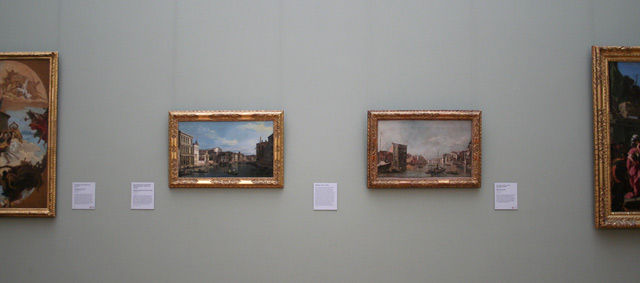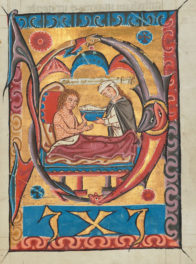
Two views of Venice\’s Grand Canal in the Getty Center\’s South Pavilion galleries. At left, Canaletto’s The Grand Canal, Venice, from Palazzo Flangini to the Church of San Marcuola, painted around 1738, on loan from a private collection. At right, Francesco Guardi’s The Grand Canal, Venice, with the Palazzo Bembo, painted around 1768, from the J. Paul Getty Museum’s collection
Picture this: You’re in the 18th century taking a Grand Tour across Europe, making all the “in” stops such as France and Italy. Before heading back home, you have one final task: buying souvenirs! You’ve taken fencing lessons in Paris, seen the historic ruins in Rome, and navigated the Alps, so what do you bring back to remember this monumental adventure?
Today, the most popular souvenirs are postcards—we sold over 130,000 of them at the Getty Center Museum Store last year. Chloë Simon, Museum Stores manager, told me, “It’s not unusual for customers to purchase 10 to 20 postcards at one time, often as souvenirs of their favorite works of art in the Museum.”
In the 18th century, before the advent of photography, among the most sought-after souvenirs were paintings of popular European landmarks and views. They were most fashionable in Venice, where two painters in particular made their success. Giovanni Antonio Canal, better known as Canaletto, and Francesco Guardi made their marks as vedutisti, or view painters. Their canvases were especially popular among British tourists making their stop in Venice as a part of their European tour.
The Getty is lucky to have a view of Venice’s Grand Canal by Guardi in our permanent collection, as well as one by Canaletto that’s on loan through summer 2011. These vedute are particularly interesting because they both depict the same section of the canal. While Guardi’s painting looks toward the west, Canaletto’s faces the east. A few key buildings—such as the now-vanished Palazzo Bembo—are represented in both, from different angles. Palazzo Flangini, at left in the Canaletto, appears in the Guardi on the right side of the canal in the middle distance; it’s identifiable by its darkened facade.

The Grand Canal, Venice, from Palazzo Flangini to the Church of San Marcuola, Canaletto, around 1738. Private collection

The Grand Canal, Venice, with the Palazzo Bembo, Francesco Guardi, about 1768
Can you imagine bringing back a painting as a souvenir from your next trip? Although we no longer commission paintings during vacations, the practice of bringing back a veduta nevertheless remains popular. Many of the postcards bought at the Getty Museum Stores, for example, depict views of the Getty Center and Getty Villa sites. So while we might not bring back full-size paintings from our travels any more, taking home a picture of what we’ve seen is a practice that goes back centuries.




Comments on this post are now closed.